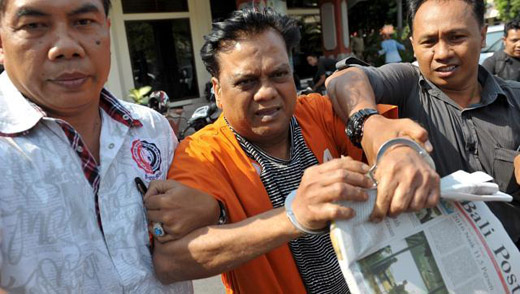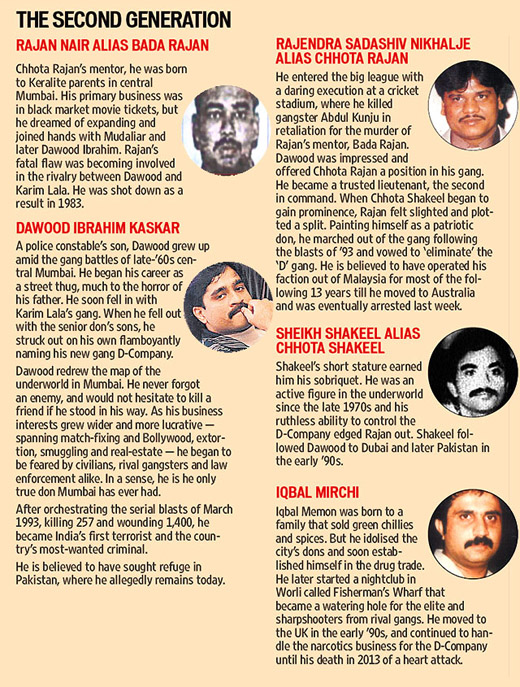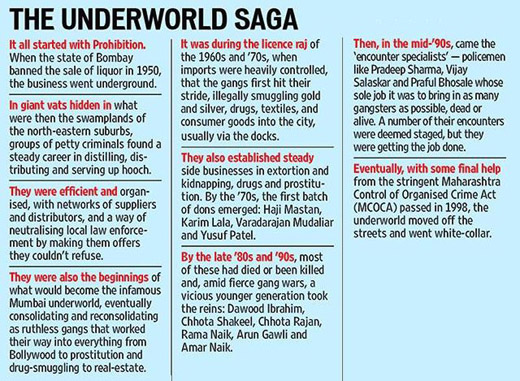Chhota Rajan heads home; time to look at the new-age underworld
mangaloretoday.com HT
Mumbai, Nov.01: When the firing started at Leopold Café on 26/11, many people of a certain age put it down to a gang brawl. The truth is, those days are over.
The only times gangsters shoot at each other on the streets of Mumbai, and innocent civilians duck for cover or end up dead, are in Bollywood films. Today’s underworld is more likely to be poring over spreadsheets and logging onto Skype.

Where they once squabbled over dimly lit gambling and prostitution dens and proved their mettle through bloodshed and extortion, they now monitor construction projects and solve multi-crore family land disputes for a commission.
In January 2014, for instance, police officials investigating the murder of young techie Esther Anuhya stumbled upon a telephonic conversation between two gangsters. They were discussing a family dispute involving a multi-crore plot of land in the central suburbs of Mumbai.
“If a gangster can solve a 100 crore property dispute, he gets a minimum 10%?as commission,” says a Mumbai police officer, on condition of anonymity. “They no longer need to encroach on each others’ territory. In fact, they now make an effort to sort out differences amicably.”
This amicability also has its roots in the bloody ’80s and ’90s, when a generation of under-the-radar dons in white suits and matching Mercedes cars was replaced by a scheming, ambitious and ruthless band of youngsters that included Dawood Ibrahim, Chhota Rajan, Chhota Shakeel, Rama Naik and Arun Gawli.
In scenes straight out of The Godfather, gangsters cut each other down at cricket matches, on the streets in broad daylight, and in hair-cutting saloons.
After Chhota Rajan — now in the news for his arrest in Bali — split from the Dawood gang in 1993, the mayhem intensified. The bloodshed finally became too big an embarrassment for law enforcement. But the police force was so infiltrated that the only way out seemed to be to start over.
And so Mumbai’s infamous encounter specialists were born. The fact that a number of their encounters were staged and their targets sometimes pre-selected didn’t matter. They were getting the job done; eventually they got the job done.

With some final help from the stringent Maharashtra Control of Organised Crime Act (MCOCA) passed in 1998, the underworld moved off the streets and went white-collar. “They still kept guns in their drawers, but they earned their money through investments,” says a Crime Branch official. These investments — primarily in Mumbai’s extremely lucrative real-estate sector — are part of the reason you can’t afford a flat today.
Those mysterious investors you keep reading about, snapping up houses regardless of cost, are often laundering money made decades ago, turning it legit and then working and reworking their investment portfolios for profit. They still smuggle drugs, arms and gold, but these former mainstays now form a sliver rather than a chunk of their operations.
“There is none of the former fight-to-thedeath loyalty now,” says the Crime Branch officer. “None of that ‘code of honour’.”
The one thing that hasn’t changed is the strained Dawood-Chhota Rajan rivalry. Rajan’s return to Mumbai could trigger unrest; it is being seen as a deliberate ploy to undermine Dawood in the city. The dynamics will now depend on Rajan’s calculations — how far will he want to take the fight with D-Company?
A nationwide network
While Mumbai’s underworld is, let’s say, the most cinematic, with UP coming a close second, there are vibrant networks of gangs across the country, some criss-crossing state lines, others totally contained within them. A look at their origins and evolution...
Mangalore
In the 1980s, when criminal gangs in Bangalore were still using swords and machetes, dons of Mangalore such as Sadhu Shetty had already graduated to automatic weapons and were working with international crime syndicates with interests in smuggling gold, small arms and ammunition, stock market scams and film financing.
Many Mumbai gangsters hailed from small villages in and around Mangalore: Ashok Shetty, Ravi Pujari, Madur Yusuf. As a recruitment ground for Mumbai dons, Mangalore came second only to eastern Uttar Pradesh.
“Mangalore’s dons were using satellite phones and making VoIP calls when we were just about mastering the technology of tapping cellphones,” says a recently retired IPS officer.
After the Mumbai serial blasts of 1993, communal tones entered the underworld, says an intelligence officer, and the last decade has seen several assassinations: Bajrang Dal leaders Sukananda Shetty (2006), Pollali Ananthu (2008) and Candle Santhu (2009), communist leader Srinivas Bajal (2002), Muslim extremist Ameer (2004) and human rights lawyer Naushad Kashimji (2009).
Mangalore’s dons are no longer motivated by profit alone.

Delhi
Here, organised crime takes the form of numerous small gangs rather than large syndicates, and the underworld’s business models have moved in ways that can be mapped and correlated with the development of the National Capital Region over the past 20 years.
Groups that once thrived on extortion, betting and gambling on the fringes of Delhi have moved to land-grabbing and real-estate rackets. They now collect ‘protection fees’ from landowners to stave off rival gangs. Or, in the case of disputed plots, use strong-arm tactics to force landowners to sell at throwaway prices.
The establishment of new industrial areas in NCR, meanwhile, has seen several groups that once made a living on pickpocketing and petty theft graduate to kidnapping and extortion.
In terms of territory, gangsters such as Neeraj Bawana, Naveen Bali, Vikas Langarpuri and Dheerpal Kana have retained strongholds in outer Delhi’s Kanjhawala, Narela and Karala.
Others like Naresh Kala, Munna Bajrangi and Amit Bhura maintain bases in border areas such as Sonepat, Ghaziabad, Greater Noida and Dehradun and collaborate with the Delhi gangs.
Gurgaon
There were no real gangs in Gurgaon before the 1990s, mainly because there was little to gain from what was then little more than a dusty village.
Former advocate Bunty Yadav alias Fauji first saw potential for organised crime here, setting up a gang in 1995 that specialised in extorting money from local businessmen and landowners.
He was quickly followed by local criminal Rajje alias Rajesh Punjabi and, immediately, the gangland battles began.
In 1996, Fauji shot Rajje and a battle over territory ensued in what was by now a rapidly urbanising region of skyrocketing real-estate prices. By 1998, a wannabe don emerged, in the form of dismissed Delhi police constable Dilip Kumar, who named his gang after Mumbai don Dawood Ibrahim’s D-Company.
This gang was a trendsetter in the extortion business, even murdering a prominent jeweller when his family couldn’t pay the Rs 25 lakh ransom. The gang fell apart in 2001, though, after Dilip was arrested.
A number of smaller gangs erupted between 1995 and 2005 but were finished off, either in police crackdowns or gang rivalries. These included the gangs of Sunil Takla, Dharambeer Ullahwas, Sudesh alias Chailu and Raju Langda.
“There has never been a major gang leader in the city who could call the shots or dictate terms,” says Gurgaon police commissioner Navdeep Singh Virk.
(With Sudipto Mondal in Bengaluru, Karn Pratap Singh in Delhi, Leena Dhankhar in Gurgaon)
- Karnataka police launches new website for payment of fines on traffic rule violations
- Udupi: Astrologer arrested for sexually abusing teenager
- Changes in train services due to maintenance works between Nethravathi Cabin-Mangaluru Junction
- Sullia: Car rams into hotel wall; couple injured
- Bantwal: Tipper-scooter collision claims rider’s life
- Protest against toll gate: Court summons to 101 activists
- Lakshadweep-Mangaluru passenger vessel service resumes
- Five-day mango, jackfruit mela at Kadri Park from May 9
- Change in train services due to track maintenance works
- Hot and humid conditions likely to prevail till Saturday in coastal districts
- Kundapur: Boat goes off track as fishermen doze off
- Mangalore University hostel students protest against poor quality food
- Bonda factory gets clean chit in alleged food poisoning case
- Rahul contesting Raebareli seat out of fear of defeat from Wayanad: MP CM Yadav
- 97.76% of Rs 2000 banknotes returned, Rs 7,961 Crore yet to be deposited: RBI
- Rahul Gandhi files nomination from Raebareli, accompanied by Sonia Gandhi, Priyanka
- ICC Rankings: Australia wrest top position in Tests but India remain No. 1 in ODIs and T20Is
- No side effects from our vaccine: Covaxin maker amid AstraZeneca row
- Instagram will now target accounts that repost content from others: All details
- LS Elections 2024: Modi steering India to dictatorship, says Sharad Pawar
- Rape case against Karnataka MP Prajwal Revanna in sex tapes scandal
- Air conditioner explodes at Kalyan Jewellers store in Karnataka, 3 injured
- Congress picks Rahul Gandhi for Raebareli, KL Sharma for Amethi
- Prajwal Revvanna’s driver who leaked sex tapes goes missing
- Modi should apoligise to all womens for helping ’mass rapist’ Prajwal fly to Germany - Rahul
- New residential complex for the judges inaugurated in Mangaluru
- Absconding accused nabbed after 8 years
- Truck with cylinders turns turtle in Beltangady
- Bhoota Kola artist dies of cardiac arrest
- Development of the country should be our goal: Ganesh Karnik
- Container truck gets stuck under Modankap railway bridge
- Truck crushes bike’s pillion rider near BC Road
- Head constable dies of heart attack
- Udupi: PDO dismissed over financial irregularities
- CREDAI to resume Skill Development Program for Construction Workers in Mangaluru
- John B Monteiro elected president of Rachana Catholic Chamber of Commerce & Industry
- Sudhanshu Rai elected district president of All College Student Association
- Chief Minister to visit Mangaluru, Udupi on August 1
- Nitte University awards PhD degree to Tina Sheetal D’Souza
- Sachitha Nandagopal honoured by CMTAI for Community Service
- CITY INFORMATION
- TRAVEL
- TOURIST INFORMATION
- HEALTH CARE
- MISCELLANEOUS




 Write Comment
Write Comment E-Mail To a Friend
E-Mail To a Friend Facebook
Facebook Twitter
Twitter  Print
Print 

